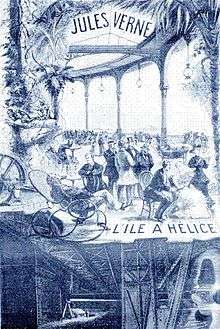Propeller Island
 | |
| Author | Jules Verne |
|---|---|
| Original title | L'Île à hélice |
| Translator | William John Gordon |
| Illustrator | Léon Benett |
| Country | France |
| Language | French |
| Series | The Extraordinary Voyages #41 |
| Genre | Adventure novel |
| Publisher | Pierre-Jules Hetzel |
Publication date | 1895 |
Published in English | 1896 |
| Media type | |
| Preceded by | Captain Antifer |
| Followed by | Facing the Flag |
Propeller Island (French: L'Île à hélice) (also published as The Floating Island, or The Pearl of the Pacific) is a science fiction novel by French author Jules Verne (1828–1905). It was first published in 1895 as part of the Voyages Extraordinaires. It relates the adventures of a French string quartet in Milliard City, a city on a massive ship in the Pacific Ocean, inhabited entirely by millionaires.
Plot

A French string quartet (Sébastien Zorn, Frascolin, Yvernes and Pinchinat), traveling from San Francisco to their next engagement in San Diego, is diverted to Standard Island. Standard Island is an immense man-made island designed to travel the waters of the Pacific Ocean. The wealth of residents of the island can only be measured in millions. The quartet is hired to play a number of concerts for the residents during their tour of the islands (Sandwich, Cook, Society) of the South Pacific. The island seems an idyllic paradise; however, it is an island divided in two. The left half's population is led by Jem Tankerdon and is known as the Larboardites. The right half's population is led by Nat Coverley and is known as the Starboardites. Despite the obstacles encountered on their journey, the two parties have a disagreement that threatens the future of the island itself.
English versions
In October, 1896 Sampson Low (London) published the novel as The Floating Island, or The Pearl of the Pacific, translated by W. J. Gordon, with 80 illustrations. While Gordon was an accomplished translator, boy's author, and literary figure with an accurate translation of Verne's The Giant Raft to his credit, the dark social commentary of Propeller Island did not sit well with his publishers, and numerous alterations in the text were made. As Arthur B. Evans notes:
The equivalent of dozens of pages have been cut from this Verne story because they were viewed as being somehow critical of the Americans or the British. Such unacceptable passages included a description of the United States doubling its size by annexing Canada and Central America (I§1), a short blurb making fun of England’s refusal to adopt the metric system (I§5), several very anti-American paragraphs focusing on the colonial history of Hawaii (I§9), a discussion about corrupt British politics (I§13), a few paragraphs concerning the lack of manners of many British citizens (II§1), a lengthy discussion where the British are condemned for introducing snakes onto the islands of Martinique and Guadeloupe before handing them over to the French (II§6), and a comical dialogue comparing the British to cannibals (II§9). Sometimes such changes, though distressing, can be inadvertently humorous. In one problematic passage—a long anti-missionary diatribe that the translator apparently decided could not be easily cut from Verne’s narrative—a simple but ingenious solution was found: the nationality of the rapacious cleric was simply changed from British to German(II§1.190)."[1]
Gordon's translation was also used for the only fully illustrated American edition of the book, published in November 1897 by W. L. Allison. Other publishers were Hurst and Company and the Donahue Brothers.
In 1967 Sidgwick and Jackson (London) published an abbreviated version of the work in the Fitzroy Edition as Propellor Island. In 1990, Keegan Paul (US) republished the Allison edition of The Floating Island without illustrations and with an introduction by Kaori O'Connor.
References
- ↑ Evans, Arthur B. (March 2005). "Jules Verne's English Translations". Science Fiction Studies. 1. XXXII (95): 80–104. Retrieved 6 September 2012.
External links
| Wikimedia Commons has media related to Propeller Island. |